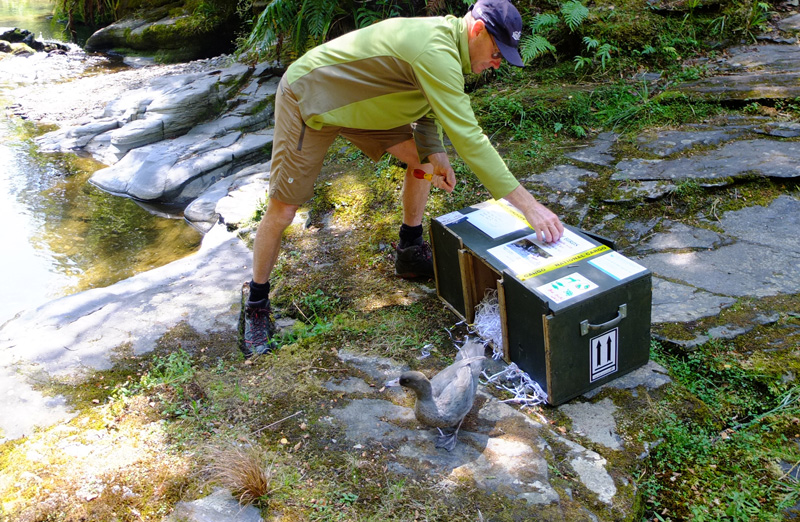Archived content: This media release was accurate on the date of publication.
Date: 28 February 2019
Three young whio/blue ducks were this week the first to be released into the Wangapeka-Fyfe Whio Security Site in Kahurangi National Park as part of a new ‘breed for release’ programme to boost whio numbers.
In the ‘breed for release’ programme, five adult whio pairs living at wildlife centres breed whio for release into South Island rivers.

DOC ranger Brent Hartshorne releases the whio
Image: DOC
The Wangapeka -Fyfe Whio Security Site receives funding from the Whio Forever programme that is a partnership between Genesis and DOC.
DOC Motueka Ranger Ivan Rogers says the new captive breeding programme should enable fast growth in whio numbers in this area of Kahurangi National Park over the coming years.
"Captive whio lay between four and eight eggs and they can produce two or three clutches in a breeding season. To encourage the whio pairs to produce more clutches, eggs from their first one or two clutches are taken from them after 10 days of incubation to be hatched and raised at The Isaac Conservation and Wildlife Trust in Christchurch."
According to Cam Speedy, Genesis Senior Environmental Coordinator and advisor to the Whio Forever technical committee, the breed for release programme can only work because of the extensive predator control network in the region and the dedication of the DOC whio experts.
"The South Island presents different challenges to the North Island in terms of whio protection in that the river systems and catchments are so much bigger. This means the number of traps required to protect the area has to significantly increase," says Cam Speedy.
"These ducklings have a much better chance of survival today than even a few years ago. The numbers we are now seeing in this whio security site are incredible and it is a credit to the hard work and determination of those involved."
Ivan Rogers says, "We really appreciate the support of The Isaac Conservation and Wildlife Trust and the other wildlife centres involved for their help with this breed for release technique that is valuable for increasing whio numbers."
The Wangapeka-Fyfe Whio Security Site was established in 2003 with a goal to protect 50 pairs. In early 2017, 43 adult pairs were found in the most recent count using whio-detecting conservation dogs.
An extensive stoat trapping network and aerial 1080 predator control are helping to protect the Wangapeka-Fyfe whio. Stoats are the main threat to whio, stealing eggs and preying on nesting females and ducklings.
Monitoring has shown more ducklings were produced in the site in breeding seasons when aerial 1080 predator control has taken place. After a 2011 OSPRI operation, 48 whio ducklings were recorded and after DOC operations in 2014 and 2016, 65 and 40 respectively. In the intervening years, 21, 18, 23 and 28 whio ducklings were counted and 22 last year.
Background information
The Wangapeka-Fyfe Security Site started with one whio pair found in 10 km of waterway, and 3.6 km of stoat trap-line. It has since expanded and now has 1054 traps along 83.4 km of waterways.
Tapawera local community volunteers maintain the front country trap-lines in the Wangapeka catchment, while DOC staff and contractors manage the backcountry trap-lines.
The programme receives funding from Genesis who support nationwide efforts to secure and grow whio populations on New Zealand rivers through its Whio Forever partnership with DOC.
Whio
- The whio is a threatened species of native duck that is only found in New Zealand’s fast flowing waters. Featured on New Zealand’s $10 note and with an estimated nationwide population of less than 3000 birds, whio are rarer than kiwi.
- Whio are adapted to live on fast-flowing rivers so finding whio means you will also find fresh, fast-flowing water with a good supply of plants and underwater insects.
- This makes whio important indicators of ecosystem health – they only exist where there is quality fresh water and an abundance of life.
Whio Forever
- Genesis has a strong historic association with whio through the Tongariro Power Scheme and in 2010 this association grew through the establishment of Whio Awareness Month (March). The dates of this month have now shifted to better reflect the whio release season of mid March to mid April.
- Today, Genesis and DOC continue their partnership through The Whio Forever Project, which aims to secure the future of whio in the wild and ensure New Zealanders understand and value whio in our rivers.
- The support of Genesis and the work of DOC has enabled the Whio Recovery Plan to be implemented.
Conservation issue
- The whio are predated by stoats, ferrets and cats with the largest impact during nesting time when eggs, young and females are vulnerable, and also when females are in moult and can’t fly.
- Extensive trapping can manage these predators and work in key whio habitats by DOC and Genesis on the Whio Forever Project has already seen an increase in whio numbers.
- Whio cannot be moved to predator-free islands like other species because of their reliance on fast-flowing rivers.
- Pairs occupy approximately 1km of water – so they need a lot of river to sustain a large population and they fiercely defend their territories, which makes it difficult to put them with other ducks in captivity.
- They are susceptible to flood events which, destroy nests, fragment broods and wash away their valued food source.
Contact
For media enquiries contact:
Email: media@doc.govt.nz